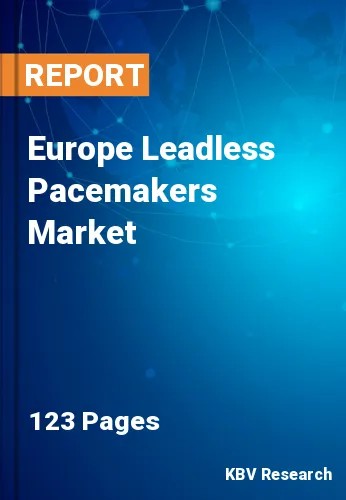The Europe Leadless Pacemakers Market would witness market growth of 14.9% CAGR during the forecast period (2023-2030).
The market has also witnessed a shift in the demographic profile of patients receiving leadless pacemakers. Initially, these devices were primarily used in older adults who required pacing therapy. However, more recently, leadless pacemakers have been implanted in younger patients, including those with congenital heart diseases. This expansion of the patient population showcases the versatility and applicability of leadless pacemakers in diverse clinical scenarios.
The rising incidence of cardiovascular conditions like atrial fibrillation and bradycardia is primarily responsible for the rising demand for the product. Numerous factors, including unhealthy lifestyle choices, obesity, and diabetes, are accountable for this. Thus, the prevalence of diabetes plays a significant role in the development of heart diseases, which in turn promotes market growth.
Furthermore, recent developments in leadless pacemaker technology have led to the integration of advanced diagnostic and monitoring features. These devices can now not only deliver pacing therapy but also collect and transmit comprehensive cardiac data. The inclusion of diagnostic capabilities, such as heart rate trends, atrial fibrillation detection, and heart failure monitoring, has positioned leadless pacemakers as multifunctional devices capable of providing valuable insights into a patient's cardiac health. This is particularly significant in the growing emphasis on preventive cardiology and the early detection of heart rhythm abnormalities.
The aging demographic in Europe is a prominent factor contributing to the higher prevalence of AF. AF is more common among older individuals, and as life expectancy increases, a more significant segment of the population is at risk of developing this heart rhythm disorder. According to Eurostat, by the year 2050, 129.8 million older people will live in the EU-27, up from 90.5 million at the beginning of 2019. In the EU region, older people are 65 or older. In the EU-27, it is anticipated that the population between the ages of 75 and 84 will rise by 56.1% during this time, while that between the ages of 65 and 74 is expected to rise by 16.6%. On the other hand, according to the most recent estimates, by 2050, there will be 13.5% fewer people in the EU-27 who are under 55.
The increasing prevalence of hypertension in Europe is the result of a complex interplay of factors, including lifestyle choices, an aging population, genetic predisposition, socioeconomic disparities, alcohol and tobacco consumption, and the effects of urbanization. Additionally, high blood pressure is a leading risk factor for AF, which further leads to increased demand for leadless pacemakers. According to Eurostat, in 2019, 22% of people in the EU aged 15 years and over reported having high blood pressure. Therefore, all of these factors will aid in the expansion of the market in the coming years.
The Germany market dominated the Europe Leadless Pacemakers Market, By Country in 2022, and would continue to be a dominant market till 2030; thereby, achieving a market value of $50,839 Thousands by 2030. The UK market is experiencing a CAGR of 13.9% during (2023 - 2030). Additionally, The France market would exhibit a CAGR of 15.8% during (2023 - 2030).
Based on Type, the market is segmented into Micra Transcatheter Pacing System, and Others. Based on End-use, the market is segmented into Hospitals, and Outpatient Facilities. Based on countries, the market is segmented into Germany, UK, France, Russia, Spain, Italy, and Rest of Europe.
Free Valuable Insights: The Global Leadless Pacemakers Market will Hit $827.7 Million by 2030, at a CAGR of 15.2%
The market research report covers the analysis of key stake holders of the market. Key companies profiled in the report include Medtronic PLC, Abbott Laboratories, Boston Scientific Corporation, Biotronik SE & Co. KG, Lepu Medical Technology Co., Ltd, Integer Holdings Corporation, MicroPort Scientific Corporation, Osypka AG, Terumo Corporation, and EBR Systems, Inc.
By Type
By End-use
By Country
Our team of dedicated experts can provide you with attractive expansion opportunities for your business.

